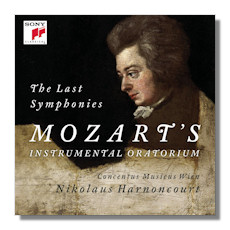
The Internet's Premier Classical Music Source
Related Links
- Mozart Reviews
- Latest Reviews
- More Reviews
-
By Composer
-
Collections
DVD & Blu-ray
Books
Concert Reviews
Articles/Interviews
Software
Audio
Search Amazon
Recommended Links
Site News
 CD Review
CD Review
Wolfgang Mozart

Mozart's Instrumental Oratorium
- Symphony #39 in E Flat Major, K. 543
- Symphony #40 in G minor, K. 550
- Symphony #41 in C Major, K. 551 "Jupiter"
Concentus Musicus Wien/Nikolaus Harnoncourt
Sony Classical 88843-02635-2 2CDS
I view Nikolaus Harnoncourt with an affectionate mix of respectful awe and pure exasperation. He's always been a tremendous Mozart conductor, and he can play Mozart with anybody, anywhere (which beats Abbado's "Mozart nowhere, with nobody"). But just because you can doesn't mean you should. Harnoncourt has now recorded the late symphonies with the Concertgebouw, Chamber Orchestra of Europe, and his own Concentus Musicus Wien, in descending order of ensemble size (and I'm not even counting DVDs). I suppose that we can now compare one man's vision across several decades and approaches, but in today's declining CD market, even I have to question the point of it all. But Mozart seems to be his newest phase, and it keeps Sony Masterworks chugging along. The conductor also sees these three final works as a single work in three parts (hence the rather silly title), and brings his new ideas to the table. So thanks, I guess?
The necessary cynicism is unfortunate, because although I didn't like this release originally, repeated hearings and adjustments to the tonal qualities of the orchestra have begun to shift my opinion quite favorably. The Symphony #39 gets less attention than its sister works, but this is an incredibly convincing performance that has almost none of the problems that plague period-instrument readings. It isn't ugly, isn't cold; isn't rushed. Harnoncourt stays out of the way and simply allows the ensemble he founded to make beautiful music. Okay, so he does some quirky things with phrasing – the Menuetto is certainly different, but super exciting – and those brass instruments are an acquired taste. But the winds and strings are on point, and the conductor largely avoids being a distraction. The man really can conduct anything and make us listen anew, it's nice that he does that here without any real issues.
In the Symphony #40, things are slightly more problematic. The first movement is beautiful, and very taut. There are also some quirks that quickly become habit, the hairpin gear shifts at the beginning and end of each theme do not impress me on repeated hearings. The inner movements are idiosyncratic, if not simply strange. Wonderfully played, yes. Idiomatic? Less so. I see what Harnoncourt is doing; these are ageless warhorses that get played over and over. These performances – this odd #40 included – are truly interesting and catch my ear at every turn. In this case, I expect that listeners will either be thrilled or appalled. The Finale is unusually measured in tempo given this date, and since the tension is maintained, it's none the worse for that. You might really like this.
Thankfully, the Jupiter is less controversial. The opening is less bracing than some, and indeed, the main theme seems rather stately. But the playing is beautiful, and the conductor deserves credit for adjusting his style to a more large-scale and Romantic conception. For a period reading, the whole affair feels rather old fashioned, and I appreciate that. The Andante is lovingly shaped, full of aristocratic grace. It seems more danceable than usual, given the sharply exaggerated accents and aggressive low strings. A true Menuetto follows, and it has less personal touches than the previous symphonies do. This is a positive thing, as it consequently feels natural. The Finale is terrific, urgently paced, but never rushed.
The sound is very good. Harnoncourt tends to favor his brass and winds, but the strings have a lively sound throughout, and never turn coarse. The notes are very deep, which will please those tired of barebones notes that seem to be economical for labels today. They will also frustrate those who just want to discover Mozart. But this is not the project that I would recommend for them, anyways. This is really for people who know Mozart and want to hear something daring and new. You'll find it here.
Copyright © 2014, Brian Wigman




















